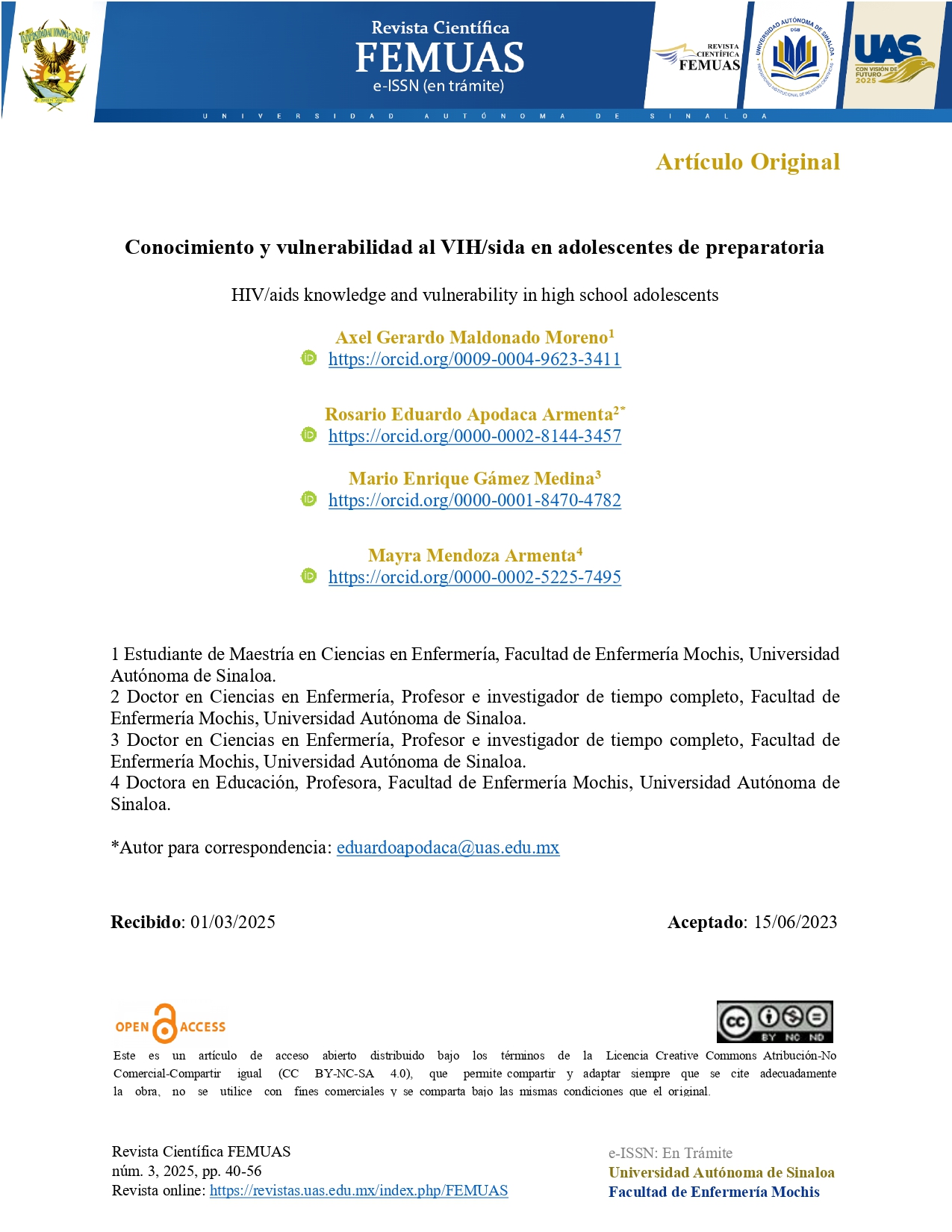HIV/aids knowledge and vulnerability in high school adolescents
Keywords:
HIV, Knowledge, Health VulnerabilityAbstract
Abstract
Background: the human immunodeficiency virus (HIV) is a problem that directly attacks the immune system. The knowledge that adolescents have about HIV/AIDS is superficial, and does not imply a change in behavior in this population, which is more vulnerable every time they have sexual relations. Objective: To describe the knowledge and vulnerability to HIV/AIDS in high school adolescents. Methodology: descriptive and cross-sectional study. The population was 1,079 adolescents from a public high school. The sample consisted of 170 participants. The multidimensional instrument of anxiety about HIV/AIDS was used (subscales of knowledge and vulnerability). Results: the highest mean was in the question I am scared when I think about getting AIDS from a sexual partner M = 1.93, SD = 1.55, the lowest mean was in the question All these discussions about AIDS make me feel a little alarmed. M = 1.32, SD = 1.40, the Mann-Whitney U test was performed, and it was found that there is no difference between the sexes for the study variables. Discussion: based on the results, we can see that adolescents do not tend to value that the little concern about this disease could substantially affect their daily life or their social relationships. However, there is a lot of concern about issues that entail sexual risk. Conclusions: adolescents do not have optimal knowledge to prevent themselves from HIV infection, the same happened with vulnerability. For both variables, knowledge and vulnerability, there was no difference based on sex.
Downloads
References
Ali-Fernández, J. L., & Quiñones-Lucen, R. A. (2020). Construcción y validación de la escala de conductas sexuales de riesgo en Universitarios de Lima [Tesis de licenciatura, Universidad Cesar Vallejo]. https://repositorio.ucv.edu.pe/handle/20.500.12692/57522#:~:text=El%20prop%C3%B3sito%20de%20esta%20investigaci%C3%B3n,de%2017%20a%2030%20a%C3%B1os
Asociación Médica Mundial (AMM, 2015). Declaración de Helsinki de la AMM –principios éticos para las investigaciones médicas en seres humanos. https://www.wma.net/es/policies-post/declaracion-de-helsinki-de-la-amm-principios-eticos-para-las-investigaciones-medicas-en-seres-humanos/
Badillo, M., Mendoza, X., Barreto, M., & Diaz, A. (2019). Comportamientos sexuales riesgosos y factores asociados entre estudiantes universitarios en Barranquilla, Colombia, 2019. Enfermería Global, 19(59). https://scielo.isciii.es/scielo.php?script=sci_arttext&pid=S1695-61412020000300422
Calafat, A., Juan, M., Becoña, E., Mantecón, A., & Ramón, A. (2021). Sexualidad de riesgo y consumo de drogas en el contexto recreativo. Una perspectiva de género. Psicothema, 21(2)
Cruz-Cruzado, A. C. (2022). Factores de riesgo para prueba de papanicolaou positiva en pacientes mujeres del Hospital I La Esperanza, [Tesis de licenciatura, Universidad Privada Antenor Orrego]. http://repositorio.upao.edu.pe/bitstream/20.500.12759/9871/1/REP_AUREA.CRUZ_FACTORES.RIESGO.PAPANICOLAOU.pdf
Dután, W., & Lliguisupa, M. (2021). Conocimientos sobre el cáncer de cuello uterino y realización de papanicolaou en mujeres de la parroquia Guapán, [Tesis de licenciatura, Universidad Católica de Cuenca]. https://dspace.ucacue.edu.ec/items/c89f0ae1-9ab4-4626-97e4-53a26e54f23a
Feldman, F., Pereyra, S., Venturini, V., Alvarez, N., Pereira, R., Correa, L., & Grazzia, R. (2021). Análisis de las conductas sexuales de riesgo en un grupo estudiante de medicina del H. de Clínicas, Archivos de Ginecología y Obstetricia, 59(1), 19-27 https://ago.uy/publicacion/1/numeros/13/articulo/analisis-de-las-conductas-sexuales-de-riesgo-en-un-grupo-estudiantes-de-medicina-del-hospital-de-clinicas
Fernández-Feito, A., Antón-Fernández, R., & Paz-Zulueta, M. (2018). Conductas sexuales de riesgo y actividades preventivas frente al cáncer de cuello uterino en mujeres universitarias vacunadas frente al VPH [Sexual risk behaviours and PAP testing in university women vaccinated against human papillomavirus]. Atención primaria, 50(5), 291–298. https://doi.org/10.1016/j.aprim.2017.05.007
Flórez-Alarcón, L., & Rubio-León, D. C. (2011). Cuestionarios para evaluar la conducta de toma de citología según el modelo de aproximación de procesos a la acción saludable. Psicología y Salud, 21(2). https://psicologiaysalud.uv.mx/index.php/psicysalud/article/view/567/974
Giménez-García, C., Nebot-García, J., Bisquert-Bover, M., Elipe-Miravet, M. & Gil-Llario, M. (2019). Infecciones de transmisión sexual en población joven ¿qué mantiene su exposición al riesgo. Revista de Psicología, 1. https://dehesa.unex.es/bitstream/10662/14414/1/0214-9877_2019_1_5_547.pdf
González-Habib, Roberto, Pastén-Zapata, Adriana Edith, & Zetina-Alvarado, Sergio. (2019). Evaluación de las conductas sexuales de riesgo y hábitos anticonceptivos en una muestra de población mexicana. Ginecología y obstetricia de México, 87(3), 153-166.https://doi.org/10.24245/gom.v87i3.2542
Guamán-Lema, A. K., & Lema-Punín, G. A. (2021). Conocimientos, actitudes y prácticas de las mujeres de la comunidad de cercapata sobre el cáncer cérvicouterino suscal, 2020, [Tesis de licenciatura, Universidad Católica de Cuenca]. http://dspace.ucuenca.edu.ec/bitstream/123456789/36293/1/PROYECTO%20DE%20INVESTIGACION.pdf
Guartán, C. (2020). PAPANICOLAOU Y LA DETECCIÓN OPORTUNA DEL CÁNCER CERVICO-UTERINO, [Tesis de licenciatura, Universidad Católica de Cuenca]. https://dspace.ucacue.edu.ec/bitstream/ucacue/10562/1/TESIS%20-%20GUADALUPE%20GUARTAN%20%20PDF.pdf
Hernández-Sampieri, R. y Mendoza Torres, C. P. (2018). Concepción o elección del diseño de investigación. En Metodología de la investigación. México: McGraw-Hill Interamericana. 2018; 5: 136-141.
Instituto Nacional de Estadística y Geografía (INEGI). Censo de Población y Vivienda 2020. https://cuentame.inegi.org.mx/monografias/informacion/gto/poblacion/
Instituto Nacional del Cáncer (NIH, 2023). El virus del papiloma humano (VPH) y el cáncer. https://www.cancer.gov/espanol/cancer/causas-prevencion/riesgo/germenes-infecciosos/vph-y-cancer
Leonangeli, S., Rivarola Montejano, G., & Michelini, Y. (2021). Impulsividad, consumo de alcohol y conductas sexuales riesgosas en estudiantes universitarios [Impulsivity, alcohol use and risky sexual behaviors in college students]. Revista de la Facultad de Ciencias Medicas (Cordoba, Argentina), 78(2), 153–157. https://doi.org/10.31053/1853.0605.v78.n2.29287
Organización Mundial de la Salud (OMS, 2023). Cáncer de cuello uterino. Organización Mundial de la Salud. https://www.who.int/es/news-room/fact-sheets/detail/cervical-cancer
Organización Mundial de la Salud (OMS, 2024) Cáncer de cuello uterino. https://www.who.int/news-room/fact-sheets/detail/cervical-cancer?gad_source=1&gclid=Cj0KCQiAvP-6BhDyARIsAJ3uv7ZW6H_QiBxp2hGHKMxKG1GlPR9UKOiOC83Ao9dmbdXtb4eHDz25H68aAkO5EALw_wcB
Reyes-Narváez, S. E. & Oyola-Canto, M. S. (2022). Funcionalidad familiar y conductas de riesgo en estudiantes universitarios de ciencias de la salud. Comuni@cción, 13(2), 127-137. https://dx.doi.org/10.33595/2226-1478.13.2.687
Secretaria de Salud (SSA, 2014). Reglamento de la ley general de salud en materia de investigación para la salud. https://www.diputados.gob.mx/LeyesBiblio/regley/Reg_LGS_MIS.pdf
Tapia-Martínez, H., Hernández-Falcón, J., Pérez-Cabrera, I., & Jiménez-Mendoza, A.. (2020). Conductas sexuales de riesgo para embarazos no deseados e infecciones de transmisión sexual en estudiantes universitarios. Enfermería universitaria, 17(3), 294-304. https://doi.org/10.22201/eneo.23958421e.2020.3.703
Villanueva-González, R., & Ruvalcaba-Ledezma, J. C. (2019). La vida sexual insegura como riesgo para cáncer. Journal, 537-550.
Yovera-Jara, J.P. (2022). CONOCIMIENTO, ACTITUDES Y PRÁCTICAS FRENTE A LA TOMA DE PAPANICOLAOU EN MUJERES, AA. HH ALMIRANTE MIGUEL GRAU-II ETAPA CASTILLA- PIURA, 2022, [Tesis de licenciatura, Universidad Católica Los Ángeles Chimbote]. http://repositorio.uladech.edu.pe/bitstream/handle/20.500.13032/31233/ACTITUDES_CONOCIMIENTOS_YOVERA_%20JARA%2c_JUDITH_%20DEL_%20PILAR.pdf?sequence=1&isAllowed=y

Downloads
Published
Issue
Section
License
Copyright (c) 2025 Revista Científica FEMUAS

This work is licensed under a Creative Commons Attribution-NoDerivatives 4.0 International License.

